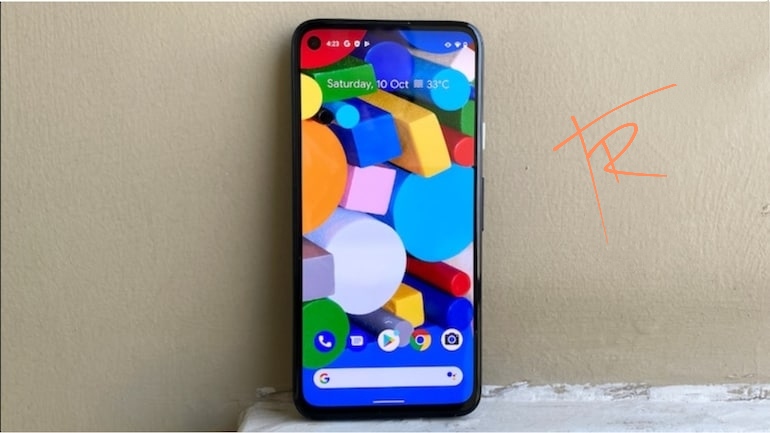
Rs. 61,999. Google Pixel 6 Expected
Traditionally we see the Google Pixel release towards the latter half of the year and Google is not changing their release schedule with the Pixel 6 which means expect the launch to happen in early October. We know a few things about the Pixel 6 already such as a new front design where the punch hole camera is not only going to be smaller than last year but Google is also changing the position from far left to the middle. Also, the handset is expected to have an in-display fingerprint scanner. That said, during an earnings call last year, Google's CEO said that they are doing some deeper investments in hardware” and that there was a “terrific roadmap ahead” in 2021. We finally got to know what he was referring to and this deeper investment in hardware is how Google is planning to make the Pixel 6 stand out from the giants, Samsung and Apple. You see, news broke out last year that Google has apparently been working with Samsung to develop a new chipset for its devices.
The new Google chipset would reportedly appear in Pixel phones as soon as this year, which means the Pixel 6 might not have Qualcomm power. Turns out the report was on point, 9to5 Google has obtained some internal Google documentation which reveals Pixel 6 will be the first Google product to have this new GS101 chip from Google. GS refers to Google Silicon and GS101 is what they are calling the chip internally. The document reveals that this codename is also directly connected to Samsung, including references to Samsung Exynos which means the Google silicon and Samsung's Exynos will have some commonalities including software components. This is in line with last year's report, that Google is teaming up with Samsung, which is providing design support and manufacturing for the project. The report says the Google SoC is an eight-core ARM processor with hardware "optimized for Google's machine learning technology" and the always-on capabilities of the Google Assistant.
The phone is powered by Octa- Core processor.It runs on the Qualcomm Snapdragon 875 (5nm) Chipset. It has 6 GB, 6 GB RAM
Camera: 16 MP + 16 MP + 12 MP
Ram: 6 GB, 6 GB
The chip would be built at Samsung's foundries on the firm's 5nm process.Google developing its own phone processor would mean dumping the Qualcomm SoCs it usually uses. Although high-end Snapdragon chips used by the vast majority of smartphone makers provide very high general-purpose as well as graphics performance, therefore enabling manufacturers to innovate with their cameras and software. However, because they are off-the-shelf, they do not carry any custom-designed exclusive hardware that could differentiate a device in terms of performance and capabilities. I mean companies like Apple, Huawei and Samsung have developed their own smartphone SoCs for a while now. Apple went even further and built its own highly-integrated SoC for its Macs, which appeared to be quite powerful when compared to x86 processors from Intel. Furthermore, its M1 chip carries numerous special-purpose accelerators that enable performance and capabilities not accessible to off-the-shelf CPUs, which changes the way Apple's processors can be used. So it's only natural for Google to get into building the chips that its OS runs on. It will allow them to optimize the chip design to how the next version of their OS and Apps will need to run most efficiently.
Also, Google's current chips that include Pixel Neural core which is camera silicon will work better on Google's in-house designed main chip since Google can tweak controls however they want which is something not possible with off-the-shelf Qualcomm's chips. So an SoC division would give Google some much-needed flexibility when it comes to hardware. This will allow Google to innovate its Android and Chrome OS platforms quickly and stay competitive with Apple and Microsoft since it is considerably easier to implement certain features into in-house designed silicon than persuade a third party to incorporate something into their SoC. Also this means the Pixel 6 will have a proper in-house flagship processor and not a midrange one.
HERE WE GO
So the Google Pixel 5 hasn’t been out forthat long, the phone was only launched in October last year but the world of smartphonesmoves fast and we already have some potential details of the next flagship phone from Google,the Pixel 6. The internal code names for the future Pixelphones have been leaked last year, Passport, Raven, and Oriole. Passport is for the alleged foldable phonefrom Google that may or may not launch this year. But Raven and Oriole are for the Pixel 6 andperhaps the Pixel 6 XL. Google decided against releasing a Pixel 5XL last year because they changed their direction slightly when it comes to their phone releases,with the company moving away from fitting them out with the very best available tech. Instead, all the Google phones last year includemore modest mid-range chipsets and price tags that sit below rival handsets from Samsungand Apple. They were also notably smaller phones, offeringa respite from the usual barrage of huge Android devices. But that could change this year accordingto these internal code names. You see the developer preview of the Android12 is out already and there are a few interesting hidden details inside the build. Notably and I quote "Make unlocking your phonea breeze," "Save time unlocking phone in your pocket," and "Unlock your phone securely withyour face and fingerprint."

Now based on these hidden codes, a lot ofpeople are believing the Pixel 6 will have an in-display fingerprint scanner, plus Googlewill bring back the face unlock feature with the Pixel 6 something we saw on the Pixel4. Now, even though the in-display fingerprintscanner has become a native Android feature with the Android 12, it doesn't guaranteethat we will see the feature on the Pixel 6 or Pixel 6 XL. Though you can't rule out the possibilityeither. It seems the ditching of the Pixel 5 XL modelwas a result of the knock-on effects of Covid-19, if that's indeed the case then hopefully in2021 things will be different. We might see a return to the high-end spacewith a Pixel 6 XL packing a Snapdragon 888 chipset, and hence an in-display fingerprintscanner is very much a possibility.
As for the in-display face scanner, thoughI don't think that would happen. Yes, we've seen patents from Apple about incorporatingthe faceID sensors under the display but I don't think that will happen anytime soon. It's a very complex technology for a biometricsolution, yes we already have the under-display front camera but don't expect under-displaybiometric solutions anytime soon. Anyway, The Pixel range has always had a strongreputation for excelling in the camera department. And while we’re certainly impressed withthe pictures produced by the Pixel 5, in some ways that model felt like a step back andthat's due to the use of an IMX363.1.1.2MP sensor which was pretty dated even on release.

So I hope the Pixel 6 would see a new camerasensor to once again put Google on top when it comes to mobile cameras. It has worked wonders with AI and computationaltech; however, it does now feel that the current sensor has reached its limit. Samsung and Apple phones take better photosthan a Pixel phone these days and it doesn't feel like Google has any competitive advantage. Plus Google removed the telephoto lens featuredon the Pixel 4 for some reason, so here's hoping that the next Pixel at least has 3main cameras normal, wide and telephoto to even the playing fields. With that being said, If you had to pick onlyone upgrade for the Pixel 6
FOR MORE ARTICLES :- https://techreviewsxd.blogspot.com/?m=1






0 Comments